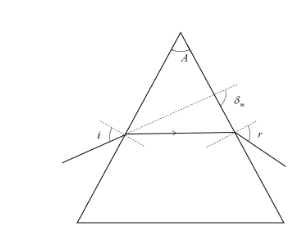
For the angle of minimum deviation of a prism to be equal to its refracting angle, the prism must be made of a material whose refractive index:
\[A)\] Lies between \[\sqrt{2}\] and \[1\].
\[B)\] Lies between \[2\] and \[\sqrt{2}\].
\[C)\] Is less than \[2\].
\[D)\] Is greater than \[2\].
Answer
497.4k+ views
Hint: Firstly we need to draw a diagram to understand the situation clearly. We will use the equation to find the refractive index of a prism and substitute the given situation of angle of minimum deviation in the expression and hence obtain an equation for the refractive index. Then we will apply the limit from \[0{}^\circ \] to \[90{}^\circ \] and obtain the range of refractive index which we could have using the given angle of minimum deviation.
Formula used:
\[\mu =\dfrac{\sin \dfrac{\left( A+{{\delta }_{m}} \right)}{2}}{\sin \dfrac{A}{2}}\]
Complete step by step answer:
We will draw the diagram using the parameters, angle of prism as (\[A\]), angle of incidence (\[i\]), angle of refraction (\[r\]) and angle of minimum deviation (\[{{\delta }_{m}}\]).

It is given that angle of minimum deviation to be equal to the refracting angle.
\[\Rightarrow {{\delta }_{m}}=A\]
Now, we will substitute this in the equation to find the refractive index of prism and it will become,
\[\mu =\dfrac{\sin \dfrac{\left( A+A \right)}{2}}{\sin \dfrac{A}{2}}=\dfrac{\sin \left( A \right)}{\sin \dfrac{A}{2}}\]
Now, we will use the trigonometric relation \[\sin \left( x \right)=2\sin \left( \dfrac{x}{2} \right)\cos \left( \dfrac{x}{2} \right)\].
\[\Rightarrow \mu =\dfrac{\sin \left( A \right)}{\sin \dfrac{A}{2}}=\dfrac{2\sin \left( \dfrac{A}{2} \right)\cos \left( \dfrac{A}{2} \right)}{\sin \left( \dfrac{A}{2} \right)}\]
\[\mu =2\cos \left( \dfrac{A}{2} \right)\]
So, we have the expression for a refractive index.
Now we will apply the limit for angle of prism from \[0{}^\circ \] to \[90{}^\circ \]. Then, if \[A\] is \[0{}^\circ \],
\[\mu =2\cos \left( \dfrac{0}{2} \right)=2\]
And if \[A\] is \[90{}^\circ \], \[\mu =2\cos \left( \dfrac{90}{2} \right)= 2\cos \left( 45 \right)=\sqrt{2}\]
So, we can conclude that the prism could have a refractive index which lies between \[2\] and \[\sqrt{2}\].
So, the correct answer is “Option B”.
Note:
The soul of this question is situated at the part where we are applying the limit for \[A\].
There we are taking the angles \[0{}^\circ \] to \[90{}^\circ \] because they are the maximum and minimum angles which a prism could have. We are taking \[{{\delta }_{m}}=A\] because if the minimum deviation is equal to refracting angle, by geometry, the angle of prism and the refracting angles will be equal.
Formula used:
\[\mu =\dfrac{\sin \dfrac{\left( A+{{\delta }_{m}} \right)}{2}}{\sin \dfrac{A}{2}}\]
Complete step by step answer:
We will draw the diagram using the parameters, angle of prism as (\[A\]), angle of incidence (\[i\]), angle of refraction (\[r\]) and angle of minimum deviation (\[{{\delta }_{m}}\]).

It is given that angle of minimum deviation to be equal to the refracting angle.
\[\Rightarrow {{\delta }_{m}}=A\]
Now, we will substitute this in the equation to find the refractive index of prism and it will become,
\[\mu =\dfrac{\sin \dfrac{\left( A+A \right)}{2}}{\sin \dfrac{A}{2}}=\dfrac{\sin \left( A \right)}{\sin \dfrac{A}{2}}\]
Now, we will use the trigonometric relation \[\sin \left( x \right)=2\sin \left( \dfrac{x}{2} \right)\cos \left( \dfrac{x}{2} \right)\].
\[\Rightarrow \mu =\dfrac{\sin \left( A \right)}{\sin \dfrac{A}{2}}=\dfrac{2\sin \left( \dfrac{A}{2} \right)\cos \left( \dfrac{A}{2} \right)}{\sin \left( \dfrac{A}{2} \right)}\]
\[\mu =2\cos \left( \dfrac{A}{2} \right)\]
So, we have the expression for a refractive index.
Now we will apply the limit for angle of prism from \[0{}^\circ \] to \[90{}^\circ \]. Then, if \[A\] is \[0{}^\circ \],
\[\mu =2\cos \left( \dfrac{0}{2} \right)=2\]
And if \[A\] is \[90{}^\circ \], \[\mu =2\cos \left( \dfrac{90}{2} \right)= 2\cos \left( 45 \right)=\sqrt{2}\]
So, we can conclude that the prism could have a refractive index which lies between \[2\] and \[\sqrt{2}\].
So, the correct answer is “Option B”.
Note:
The soul of this question is situated at the part where we are applying the limit for \[A\].
There we are taking the angles \[0{}^\circ \] to \[90{}^\circ \] because they are the maximum and minimum angles which a prism could have. We are taking \[{{\delta }_{m}}=A\] because if the minimum deviation is equal to refracting angle, by geometry, the angle of prism and the refracting angles will be equal.
Recently Updated Pages
Express the following as a fraction and simplify a class 7 maths CBSE

The length and width of a rectangle are in ratio of class 7 maths CBSE

The ratio of the income to the expenditure of a family class 7 maths CBSE

How do you write 025 million in scientific notatio class 7 maths CBSE

How do you convert 295 meters per second to kilometers class 7 maths CBSE

Write the following in Roman numerals 25819 class 7 maths CBSE

Trending doubts
Give 10 examples of unisexual and bisexual flowers

Draw a labelled sketch of the human eye class 12 physics CBSE

Differentiate between homogeneous and heterogeneous class 12 chemistry CBSE

Differentiate between insitu conservation and exsitu class 12 biology CBSE

What are the major means of transport Explain each class 12 social science CBSE

Franz thinks Will they make them sing in German even class 12 english CBSE




